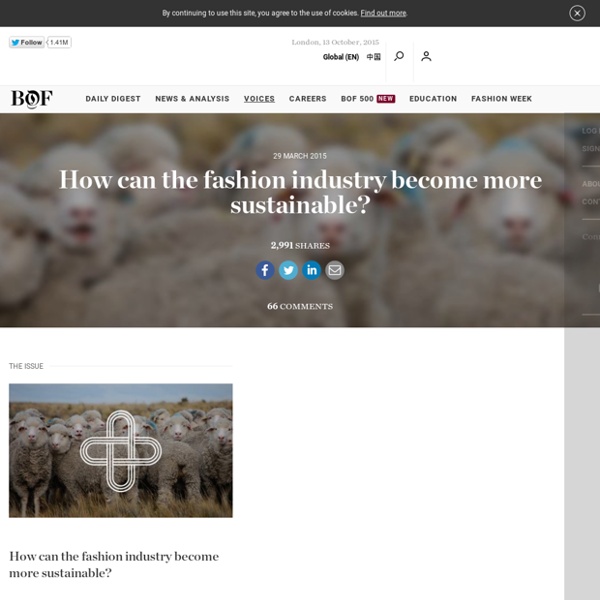



Raw for the Oceans « Ecouterre Bionic Yarn estimates that the full collection employs an estimated 10 tons of recycled marine debris. The line, which includes T-shirts, hoodies, boilersuits, trench coats, bomber jackets, jeans, and baseball caps in dark blue and black, features subtle detailing, plus original motifs based on its “Otto the Octopus” logo. RELATED | Pharrell, G-Star Raw Create Denim Made From Recycled Ocean Plastic Raw for the Oceans will be available for men and women in September, but it’s already making an impression. “The end result was the clothing itself,” U.S. judge Dan Formosa, a designer at Smart Design, told Ad Age. + Raw for the Oceans + G-Star Raw
Where do your old clothes go? 11 February 2015Last updated at 10:01 ET By Lucy Rodgers BBC News Every year, thousands of us across the UK donate our used clothing to charity - many in the belief that it will be given to those in need or sold in High Street charity shops to raise funds. But a new book has revealed that most of what we hand over actually ends up getting shipped abroad - part of a £2.8bn ($4.3bn) second-hand garment trade that spans the globe. Continue reading the main story How charity clothing donations end up traded abroad. Continue reading the main storyContinue reading the main storyContinue reading the main story UK consumers ditch more than a million tonnes of clothing every year. The Western world's growing desire for fast, disposable fashion, fuelled by the ready supply of cheap goods manufactured in China and elsewhere, means we are consuming and then disposing of an ever greater quantity of garments. Continue reading the main story “Start Quote End QuoteDr Andrew BrooksKing's College London
Topshop Goes Green With "Reclaim" Collection of Upcycled Clothing Trish Clarke, Topshop’s head of technical services, says the collection provides an “ethical solution to disregarded material” through the retailer’s design lens. “We are inspired to challenge textile waste across our product areas, whilst still creating versatile designs that are wardrobe essentials for our customers,” Clarke says. “From ‘70s button-down dresses, to sheer-panel printed blouses, we want everyday fashion to be sustainable in Topshop’s portfolio and blueprint.” RELATED | Topshop Debuts Third Upcycled “Reclaim to Wear” Line Prices for the collection range from $22 for a ribbed camisole to $125 for a one-piece romper. Reclaim to Wear’s de Castro says she’s proud of the legacy her consultancy has left behind. Topshop previously created a line of recycled denim with musician Pharrell Williams’s Bionic Yarn firm, as well as a series of ethically produced coats with local designer Izzy Lane. + Topshop Reclaim + Topshop
Fashion meets renewable energy – clothes that charge your smartphone | Sustainable-business When you think about how fashion will work alongside technology in the future, it might be hard to break from science-fiction-heavy ideas. However, fashionably using solar, wind and even kinetic energy to charge devices, keep us connected and even donate our energy to non-profits is being explored by a number of design houses. Solar textiles Meg Grant, of Solar Fiber, says she and co-collaborators Aniela Hoitink, Marina Toeters, Ralf Jacobs, and Professor Derek Schlettwein from Giessen University are already pushing the textile boundaries in terms of solar fibres. "If you look around you, textiles cover so many surfaces, so why not give them a 'super power' that can take advantage of this, like solar energy harvesting," says Grant. The idea behind Solar Fiber is a flexible photovoltaic fibre that converts sunlight energy into electrical energy via a yarn that can be worked into all sorts of fabrics. Kinetic energy Energy harvesting The sustainable fashion hub is funded by H&M.
Wearable pineapple fibres could prove sustainable alternative to leather | Business At weddings and formal events in the Philippines, men can often be seen wearing the Barong Tagalog, a thin and transparent embroidered garment worn over a shirt. One of the more surprising materials used in its manufacture are fibres from pineapple leaves – and long strands of the leaves could soon also be used to make a host of other products, from trainers and clothes to bags and car upholstery. Called Piñatex - piña is Spanish for pineapple - the new material was created by Carmen Hijosa, who worked as a consultant in the Philippines leather goods industry in the 1990s. She was unimpressed with the standard of goods produced and started to look for alternatives. It was the strength and the fineness of the pineapple leaf fibres used in the Barong Tagalog that first alerted her that there was another option: “I was looking for an alternative to leather. That was the beginning of my thinking. “We can make shoes, we can make bags. “We are completely new.